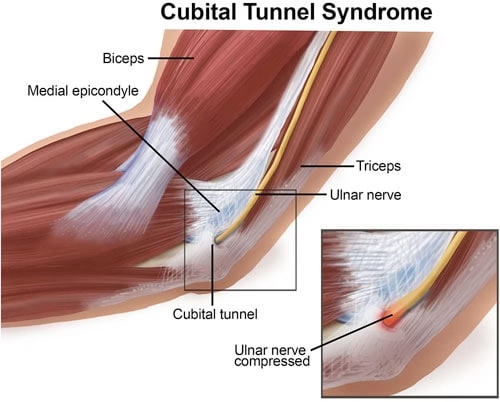Cubital Tunnel Syndrome (Ulnar Nerve at Elbow)
Cubital Tunnel Syndrome occurs when the ulnar nerve is compressed at the inner elbow. It causes tingling in the ring and little fingers, weak grip, and elbow pain that worsens when the elbow stays bent. This guide explains symptoms, tests, treatment options (non-surgical and surgical), recovery, and prevention.
Written for patients in simple language. Evidence-based, minimally invasive approach.

What is Cubital Tunnel Syndrome?
The ulnar nerve passes behind the bony bump on the inside of your elbow (medial epicondyle) through a narrow space called the cubital tunnel. Repeated elbow bending, leaning on the elbow, or tunnel narrowing can irritate the nerve. Early care reduces pressure, improves nerve glide, and protects the elbow at night. Severe or persistent weakness may need surgery to relieve compression.
Typical Symptoms
- Tingling or numbness in the ring and little fingers
- Inner elbow pain or burning, worse with prolonged bend
- Weak grip, dropping objects, clumsiness while typing
- “Electric shock” along forearm when elbow is bumped
- Advanced cases: muscle wasting on hand’s inner side
Causes & Risk Factors
- Long periods of elbow flexion (phone use, sleeping bent)
- Leaning on elbows (desk edge, armrest, cycling)
- Post-injury or arthritis narrowing the tunnel
- Repetitive bend–straighten tasks at work or sport
- Snapping/subluxing ulnar nerve (anatomical variant)
- Diabetes, thyroid issues, smoking (nerve health)
How we diagnose it
- Clinical exam: sensation, intrinsic hand strength, Tinel’s sign at elbow, elbow-flexion test
- Nerve tests: NCS and EMG to grade severity and guide decisions
- Imaging (selected): ultrasound or MRI for structural causes or recurrent cases

Treatment Options
Non-surgical (first line)
- Activity change: avoid elbow-leaning; keep elbows slightly straighter; use headset for calls
- Night positioning: soft towel wrap or splint to limit deep bending while sleeping
- Physiotherapy: ulnar nerve glides; posture and shoulder/forearm strength
- Pain control: short course medication if appropriate
- Timeline: many mild cases improve in 6–12 weeks with consistent care
Surgical (when symptoms are severe or persistent)
- In-situ decompression: opens the tight tissue roof to free the nerve
- Anterior transposition: moves the nerve to a safer path (subcutaneous/submuscular) if it snaps or the groove is tight
- Medial epicondylectomy: selected cases with bony prominence or instability
- Decision factors: intrinsic weakness/wasting, abnormal NCS/EMG, failure of non-surgical care
For shoulder concerns, see Rotator Cuff Repair and Shoulder Arthroscopy.
Recovery timeline (typical)
Healing speed varies by severity and duration of compression. This roadmap shows common milestones.
| Phase | What to expect |
|---|---|
| 0–2 weeks | Pain/swelling settle; protect incision if surgery; gentle elbow movement. |
| 2–6 weeks | Return to light tasks; night symptoms often improve; start strength and nerve-friendly mobility. |
| 6–12 weeks | Most daily activities comfortable; numbness continues to fade. |
| 3–6 months | Nerve recovery continues; final result depends on pre-op severity and duration. |
Simple prevention habits
- Keep elbows a bit straighter during phone use or reading
- Pad armrests; avoid hard edges under the elbow
- Ergonomics: elbows ~90°, shoulders relaxed; micro-breaks every 30–45 min
- Support nerve health: manage sugars/thyroid, stop smoking
Frequently asked questions
Is this the same as carpal tunnel?
No. Carpal tunnel affects the median nerve at the wrist. Cubital tunnel affects the ulnar nerve at the inner elbow and mainly the ring/little fingers.
Will splints alone cure it?
Night splints and activity change help many mild cases within 6–12 weeks. Persistent weakness or severe numbness needs specialist review and sometimes surgery.
What tests confirm the diagnosis?
Nerve Conduction Study (NCS) and EMG measure conduction across the elbow and help grade severity.
How successful is surgery?
Most patients improve, especially night pain/tingling. Long-standing numbness or muscle wasting may take months and might not fully reverse.
Can exercises worsen symptoms?
Exercises should be gentle and nerve-friendly. Aggressive stretching of an irritable nerve can flare symptoms—follow clinician guidance.
When should I see a specialist urgently?
Sudden hand weakness, progressive numbness, dropping objects, or visible muscle wasting needs prompt assessment.
Have NCS/EMG or MRI reports? Bring them for a personalized plan.

